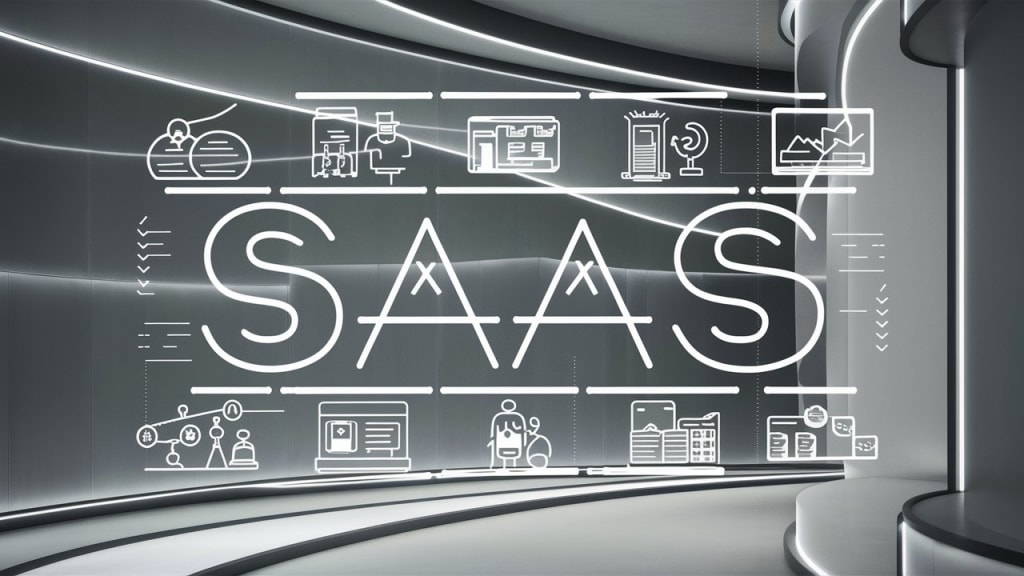SaaS Business Model Explained: Everything You Need to Know
SaaS Business Model

Ever wondered how companies like Dropbox and Slack built billion-dollar empires? The answer lies in the power of the SaaS business model. In the past seven years, the SaaS industry has expanded in size by around 500%. Moreover, the value of SaaS space is estimated around $195 billion, which makes it obvious how SaaS has revolutionized business operations and consumer interaction with technology.
But what exactly is SaaS? In essence, it’s a cloud-based software, delivered over the internet on a subscription basis. No more complex installation protocols - just simple and streamlined access to applications and tools from anywhere, anytime.
In this ultimate guide, a deep dive into the world of SaaS business models will ensue. Moreover, we’ll explore the different types of models, the revenue streams they generate. More so, we’ll examine the benefits and challenges of the SaaS business models, and help you with strategies for growing your own SaaS business and build your own SaaS product utilizing the services of a reactjs web development company. We'll also take a look at the future of SaaS to conclude our discussion.
Let’s get started.
Understanding the SaaS Business Model
The SaaS business model has revolutionized the software industry, providing both vendors and customers with unprecedented flexibility and value. To fully grasp the power of SaaS, it’s essential to understand the various models it encompasses and the revenue streams it generates.
Different Types of SaaS Business Models
SaaS is not a one-size-fits-all model. It offers a variety of approaches tailored to different customer needs and industries:
Subscription-based Model: The most common model, where customers pay a recurring fee (monthly or annually) to access the software. This provides predictable revenue for vendors and flexibility for customers to scale usage as needed.
Usage-based Model: Customers pay based on their actual usage of the software, measured by factors like data consumption, API calls, or transactions processed. This model aligns costs with value, making it attractive for businesses with fluctuating needs.
Freemium Model: A popular model that offers a basic version of the software for free, while charging for premium features or additional usage. This allows users to try the product before committing to a paid plan, driving wider adoption.
Tiered Pricing Model: Offers different pricing tiers with varying levels of features and functionality. This allows businesses to cater to a wider range of budgets and needs, from small businesses to large enterprises.
SaaS Revenue Models
The best SaaS development companies generate revenue through a variety of channels, including:
Recurring Subscriptions: The lifeblood of most SaaS businesses, providing a steady stream of income from monthly or annual fees.
Upsells/Cross-sells: Offering additional features, upgrades, or complementary products to existing customers.
Professional Services: Providing consulting, implementation, training, or customization services to enhance the customer experience and drive revenue.
Advertising: Displaying targeted ads within the software (often used in freemium models).
Transaction Fees: Charging a percentage of each transaction processed through the platform.
Benefits of the SaaS Model
The SaaS model has transformed the software landscape, offering a plethora of benefits for both the companies that create these solutions and the customers who use them.
Benefits for SaaS Providers
Lower Upfront Costs: SaaS eliminates the need for physical production and distribution, significantly reducing development and operational costs. This allows providers to invest more resources in innovation and customer acquisition.
Predictable Revenue Streams: The subscription-based model provides a steady and predictable income flow, enabling better financial forecasting and planning for future growth.
Scalability: SaaS solutions can easily be scaled up or down to meet fluctuating demand, allowing providers to cater to a wide range of customer sizes and needs.
Easier Customer Acquisition and Retention: The low barrier to entry (no upfront costs for customers) and ongoing updates make it easier to attract and retain users.
Example of SaaS Company: Adobe's transition to Creative Cloud, a subscription-based SaaS suite, resulted in more predictable revenue and allowed them to continuously deliver new features and updates to their customers.
Benefits for Customers
Affordability: SaaS eliminates the need for large upfront investments in software licenses, making powerful tools accessible to businesses of all sizes.
Accessibility: Cloud-based delivery enables users to access SaaS solutions from anywhere with an internet connection, increasing productivity and flexibility.
Flexibility: SaaS subscriptions can often be scaled to match changing needs, and users can easily switch between different plans or even providers if their requirements change.
Automatic Updates and Maintenance: Vendors handle software updates and maintenance, relieving customers of the burden and ensuring they always have access to the latest features and security patches.
Example of SaaS Company: Slack's real-time communication platform revolutionized team collaboration, offering an affordable and accessible solution that seamlessly integrates with other tools. This has made it a staple for businesses of all sizes, from startups to Fortune 500 companies.
Challenges of the SaaS Business Model
While the SaaS model offers numerous benefits, it's not without its hurdles. SaaS companies face unique challenges that require careful navigation and strategic planning.
Common Hurdles Faced by SaaS Companies
Churn: Customer churn, or the rate at which customers cancel or don't renew their subscriptions, is a constant concern for SaaS providers. High churn can significantly impact revenue and growth.
Intense Competition: The SaaS market is crowded, with new players constantly emerging. Standing out and attracting customers can be a challenge, requiring continuous innovation and differentiation.
Data Security and Privacy Concerns: As SaaS solutions often handle sensitive customer data, ensuring robust security measures and compliance with data protection regulations is paramount.
Customer Acquisition Costs (CAC): Acquiring new customers can be expensive, especially with the competition for attention in the digital space. Balancing CAC with customer lifetime value (LTV) is crucial for profitability.
Integration Challenges: Integrating SaaS solutions with existing systems or other software tools can be complex and time-consuming, leading to frustration for customers.
Growing Your SaaS Business
The SaaS landscape is competitive, but with the right strategies, you can effectively acquire and retain customers, driving sustainable growth for your business.
Proven Marketing and Sales Strategies for SaaS Companies
Content Marketing: Creating high-quality, informative content (blog posts, ebooks, webinars, etc.) establishes your brand as a thought leader and attracts potential customers organically.
Search Engine Optimization (SEO): Optimizing your website and content for search engines like Google improves visibility and drives organic traffic.
Product-Led Growth (PLG): Leveraging the product itself as a primary marketing and sales tool. This often involves freemium models, free trials, or demos to let users experience the value firsthand.
Paid Advertising: Utilizing platforms like Google Ads, social media ads, and retargeting campaigns to reach a wider audience and drive targeted traffic.
Referral Programs: Incentivizing existing customers to refer new users, leveraging the power of word-of-mouth marketing.
The Future of SaaS Business Model
The SaaS landscape is constantly evolving, driven by technological advancements and changing customer needs.
Here's a glimpse into the trends shaping the future of SaaS business model:
Artificial Intelligence (AI) and Machine Learning (ML): AI and ML are being integrated into SaaS solutions to automate tasks, personalize experiences, and provide valuable insights. This trend is expected to accelerate, making SaaS even more intelligent and efficient.
Vertical SaaS: While horizontal SaaS solutions cater to a broad range of industries, vertical SaaS focuses on specific sectors (e.g., healthcare, education, finance). This trend is gaining momentum as businesses seek specialized solutions tailored to their unique needs.
Micro SaaS: Small, niche SaaS products that focus on solving a specific problem for a specific audience. Micro SaaS startups are often bootstrapped and offer a more agile and personalized approach to software development.
Predictions for the Future of SaaS Business Models
Hybrid Models: We can expect to see a rise in hybrid SaaS models that combine different pricing structures (subscription, usage-based, etc.) to cater to diverse customer needs.
Increased Focus on Customer Success: As competition intensifies, SaaS companies will prioritize customer success initiatives to reduce churn and maximize lifetime value.
Data-Driven Decision Making: SaaS providers will increasingly leverage data analytics and AI to gain deeper insights into customer behavior, optimize pricing, and drive growth.
Consolidation: The SaaS market is likely to see consolidation as larger players acquire smaller companies to expand their offerings and market share.
Conclusion
The SaaS business models have revolutionized the software industry, providing unprecedented value and flexibility to businesses of all sizes. By understanding the different types of SaaS business models, their benefits and challenges, and the key strategies for growth, you can harness the power of SaaS to drive innovation and success in your own organization.
As we look towards the future, the SaaS landscape promises to be even more dynamic and exciting, with new technologies and trends shaping the way we create, consume, and interact with software.
If you're ready to explore the possibilities of SaaS, now is the time to dive in. Whether you're building your own SaaS product or looking for solutions to streamline your operations, the SaaS model offers endless opportunities for growth and innovation.
About the Creator
Enjoyed the story? Support the Creator.
Subscribe for free to receive all their stories in your feed. You could also pledge your support or give them a one-off tip, letting them know you appreciate their work.





Comments
There are no comments for this story
Be the first to respond and start the conversation.